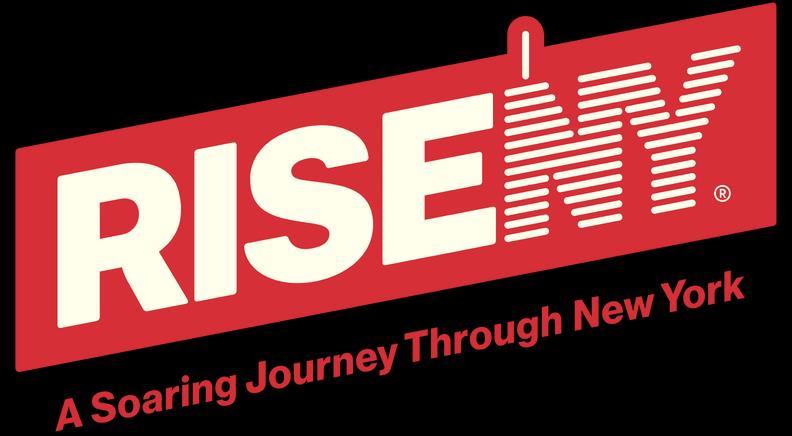Educator’s Guide



RiseNY is a three-part journey that lifts and connects you to New York City’s most famous sites and moments monuments.

First, you will enter a recreation of the old City Hall subway station and watch an 8-minute film about the history of the New York City subway system and Times Square by Ric Burns and narrated by Jeff Goldblum.
Next, you will enter the seven galleries that will transport you through the city’s expansive pop-culture evolution. Each gallery features a "Tipping Point," an innovation that led to the rise of that industry in NYC.
Finally, you will be transported back to New Years Eve of 1957. A live actor and a short video will prepare you for a soaring ride over New York City. More information about the ride can be found on our website: riseny.co
We are excited to have your group here with us for an educational and fun journey through New York City!

This guide provides your group leader with the information displayed on the panels throughout the museum experience and provides the QR codes for additional audio information found in each of the galleries.
Your students can complete the corresponding "Activity Worksheet" during your time at RiseNY. Guiding discussion questions and information to support your students in completing the Activity Worksheet can be found at the end of each gallery section of this guide.
Please use this guide and the Activity Worksheet however you see fit for your group.
New York City’s first underground subway line opened on October 27, 1904. Named the IRT, for “Interborough Rapid Transit,” this modern subway system started from the newly opened station at City Hall. The City Hall station served as the origin of the subway’s first ride Uptown, with the IRT advertising that subway riders could go “from City Hall to Harlem in 15 minutes.”
The city’s earliest subway stations featured stunning architectural details such as Gustavino-tiled ceilings, adding glamor to this modern new form of transportation. New York City’s 472 subway stations connect over 665 miles of mainline track, and with an annual ridership of around 1.7 billion in 2018 alone, New York City’s metropolitan transit system is the largest in North America, built with nonstop service in mind for the city that never sleeps.

Before the early Dutch settlers established a colony in 1624, the Lenape Indians lived here for centuries and referred to the island as “Manahatta.” The name, which later became “Manhattan, ” is generally attributed to the Lenape translation of the “island of many hills.”
Using historical records, landscape ecologists such as Eric Sanderson, using historical records have worked to reconstruct in images of what this wild island, that millions now call home, may have looked like when Henry Hudson first stepped foot on it in 1609.
Learn more about the Lenape Nation and Lenapehoking through thelenapecenter.com

The settlement of New Amsterdam (later downtown New York City) was established by the Dutch West India Company in 1624, to capitalize on the North American fur trade. It was the highly prized beaver pelt that attracted the Dutch settlers.The European market for fashionable hats made from beaver fur, plentiful in the Hudson Valley region, encouraged trade between the continents. As a result, the money-making beaver has appeared on flags and seals of this city for centuries.

In 1624, the Dutch West India Company established a colony in present-day Lower Manhattan to profit from the lucrative fur trade with Native residents of the area. The Lenape, the original inhabitants of Manhattan, had well-established trade routes over land and water, including in the area that today is known as Broadway and the Hudson River. Fort Amsterdam, on the southern tip of Manhattan, served as a Dutch trading outpost for furs being shipped for sale back in Europe.
The story of New York City’s rise as a commerce capital emerges over 400 years. Early colonial residents worked to make this city the American capital of trade and finance, with one famous city resident - Alexander Hamilton - key to creating the city’s first bank. Today’s New York Stock Exchange rose from humble origins under a tree on Wall Street to become the engine powering New York City’s rise as the world’s most significant financial capital.
The Dutch created the colony of New Netherland in the 1620s. In 1657, colonial residents of what is now Flushing, Queens, argued for religious freedom when the city’s leader, Peter Stuyvesant, tried to stop settlers from joining the colony because of their religion. Dutch leaders weighed in by saying that residents of all faiths should be welcomed freely, noting: “for we are bound by law of God to do good...unto all men.” This decision, shown in writing here, helped to attract a wide community to the colony and set the precedent for the US Constitution to guarantee freedom of worship over 100 years later. This belief is a core part of the identity of the United States as a free democracy.
Traders in New York City signed the Buttonwood Agreement in 1792 after the United States’ first securities market panic.Twenty-four New York City brokers and traders met and agreed on specific stock trading rules under a buttonwood tree at 68 Wall Street. This agreement formed the beginning of the New York Stock & Exchange Board, which later became today’s New York Stock Exchange (NYSE.)
Alexander Hamilton was a prominent New Yorker and Founding Father of the United States. Appointed in 1789,.Hamilton served as the first US Secretary of the Treasury, Raised in the Caribbean, he arrived in New York City as a teenager to study at King’s College (now Columbia University) in 1772. Hamilton joined the Revolutionary War as an officer before becoming General George Washington’s chief of staff. Hamilton was renowned as a great financial mind and also served as one of the founders of the Bank of New York, whose stock was one of the first traded on the NYSE.(see nearby check signed by Hamilton) His son, John C. Hamilton, commissioned Carl Conrads to create a sculpture of his father, by Carl Conrads, which he donated to Central Park in 1880. The plaster model for this granite statue is on view here.
As New York City grew as a major trading port and financial capital, the economy was very reliant on the slave trade. The practice of slavery was introduced by the Dutch West India Company in 1626 and ended in 1827; however, visitors were able to continue to bring enslaved people with them to New York City until 1840.
During the 17th century, The African Burial Ground emerged as a site for exclusive use by residents of African descent who were banned from the city’s church graveyards. Purchased from the Dutch in the 1630s, the burial site shown on the map of Lower Manhattan above was actively used until 1795. While the designation on the map above is no longer appropriate language, it shows where the site now properly known as the “African Burial Ground National Monument” still exists today.
Bull & Beais a bronze sculpture created by artist Isadore-Jules Bonheur in 1900.The statue reminds visitors of how stock market trading moves through “bull” markets and “bear” markets. During a “bull” market cycle, the stock market values are rising, while a “bear” market refers to a fall in stock market trading. This statue was placed in front of the New York Stock Exchange Luncheon Club entrance in 1924, where passing traders would rub the bull’s horn hoping for good luck for decades, until the statue was moved in 2006.


The Buttonwood Agreement founded the New York Stock & Exchange Board, which in turn became the New York Stock Exchange (NYSE). It is one of the world’s oldest stock exchanges. The stock exchange’s bell rests on the building’s balcony, and companies listed on the stock exchange ring the bell on active trading days during opening and closing times. Now located at 11 Wall Street, the stock exchange has defined “Wall Street” as a global financial powerhouse, as it remains the world’s largest in market capitalization and trading volume.
Additional information provided by David J Cowen, President & CEO for the Museum of American Finance




Alexander Hamilton Statue
Plaster statue by artist Carl Conrads (1880)
Flushing Remonstrance Reproduction
Original in the New York State Archives (1657)
Bull & Bear Statue
Bronze. Sculpted by Isadore Jules-Bonheur (1900)
Rub the bull's horn for luck, prosperity, and a good financial day!
Model New York Stock Exchange Bell and Balcony
The beginning and end of each trading day is marked with the ringing of the New York Stock Exchange bell. The opening bell is rung at 9:30 am ET to mark the start of the day’s trading session. At 4 pm ET the closing bell is rung and trading for the day stops. Notable bell ringers have ranged from Nelson Mandela to Liza Minnelli to Snoop Dogg.

Press the button on the wall to ring the bell!
Students are prompted to match each financial event with the year it happened. The answers can be found on panels around the gallery. The correct answers are below:
New Amsterdam was established, 1624; Flushing Remonstrance, 1657; Hamilton was appointed Secretary of the Treasury, 1789; The Buttonwood Agreement, 1792; Slavery ended in NYC, 1827; The "Bull & Bear" sculpture was created, 1900
Discussion Questions:
How do you think that New York City would be different if it t weren’t a major financial capital? Would it be as important as it is today?
After looking at the "Bull & Bear" sculpture, why do you think rising and declining stock markets are nicknamed "bull" and "bear" markets?"
(It is believed that a rising stock market cycle is called a "bull" market because a bulls raise their horns to charge, and a declining market is a "bear" market because bears swipe their paws down to attack.)
The elevator brake stunned visitors of the 1853 - 54 World’s Fair in New York City’s Bryant Park.The highlight of this fair, was the jaw-dropping elevator brake demonstration, presented by its inventor Elisha Otis (with help from P.T. Barnum). Otis had the elevator cable cut while three stories high on the elevator platform. He began to fall until the brake halted the platform seconds later. It sent the crowd into a frenzy. This device made building skyscrapers possible, elevating New York City to its full potential as a vertical metropolis.
By 1900, steel-skeleton construction and advances in elevator technology were altering the skyline of New York. The first elevator office buildings – just ten stories tall –sprouted in lower Manhattan in the 1870s, and by the end of the century, the city had a dozen towers that stretched to 20 or more stories. The tallest building downtown and in the world, the Park Row Building peaked at 391 feet.
Later, in the late 1900s, developers competed for the mantle of “world’s tallest building” leading to NYC’s “Skyscraper Wars.” Models of many of those buildings are shown in scale in this gallery.
The desire to build higher gave New York a new identity by the dawn of the twentieth century – a modern skyscraper metropolis.

New York City debuted as the Skyscraper capital of the world in the first half of the 20th century: by the year 1930, all of the world’s Top 10 Tallest buildings called Manhattan home. The buildings you see before you helped to define New York City’s famous skyline. Please notice these building models are shown in scale. You can visit all of these buildings, as well as the September 11th memorial site today.
Cities with multiple “supertall” structures - buildings over 1,250 feet high - are rare. The metropolis with the highest count is New York, with seven in total. In the aftermath of 9/11, many predicted that people would fear working or living in tall towers and that lenders wouldn’t finance them. With the destruction of the Twin Towers, New York had only one “supertall” building: the Empire State Building (built 1931.)
Today, six new buildings have surpassed the Empire State in height, and New York has the largest number of “supertalls” of any city in the world. Developers, architects and engineers [have] invented a new type of super-slender tower which rose to great heights using the zoning mechanism of transferable air rights. From 2013, these sprouted at high-value locations with great views, especially at the southern edge of Central Park and West 57th Street, [now] known as Billionaire’s Row.








Model Elevator Brake
Designed by Elisha Otis, demonstrated at the 1853-54 World's Fair
Flatiron Building
Completed 1930, 285 ft
Metropolitan Life Insurance Company Tower
Completed 1909, 700 ft
Tallest in the world from 1903 to 1913
Woolworth Building Completed 1912, 792 ft
Tallest in the world from 1913 to 1930
Chrysler Building
Completed 1930, 1,046 ft
Tallest in the world from 1930 to 1931
Empire State Building
Completed 1931, 1,454 ft
Tallest in the world from 1931 to 1970
September 11th Memorial Site
Completed 2011. Manhattan's World Trade Center (Twin Towers) rose over 1300 ft once completed by 1973, holding thw world's tallest building title one year. Following 9/11, the site became a memorial site.
One World Trade Center
Completed 2013, 1,792 ft
Tallestin the Western Hempishere since 2013

Students are prompted to label the height of each skyscraper on a chart. The heights can be found on the object table for each model skyscraper. An example is on the following page.
Students may choose to sketch a skyscraper on the chart once the heights are labeled.
Discussion Questions:

Have you ever been to the top of a skyscraper? What was it like to be up that high, or what do you think it would be like?
Which building stands out to you most in the New York City skyline? What makes it unique?
Try to solve these math problems:
GRADE 3

The Park Row Building is 391 ft tall. A single story is 14 feet tall. How much taller is the Park Row Building than a building with 10 stories?
: Complete the table below by finding the pattern.
Some of the tallest buildings in NYC are the One World Trade Building, which is approximately 1800 ft tall, the Chrysler Building, which is approximately 1000 ft tall, the Empire State Building, which is approximately 1400 ft tall, and the Woolworth Building, which is approximately 800 ft tall. Use the graph below to draw a bar graph that represents each building’s heights.
1800 ft ft
1400 ft ft
1000 ft ft
600 ft
200 ft
How much taller is the tallest building than the shortest building?
Use the ruler below to find the height of the scaled version of the One World Trade Building to the nearest 1/2 of an inch


. The footprint of the Met Life Building is shown above. What is the perimeter of the building?

Grade 4






The Met Life Tower is 210 meters tall. How many kilometers tall is it?
The Empire State Building is 57 meters wide and has an area of 736.4 square meters. What is the length of the Empire State Building?
Grade 5

The Met Life Tower is 75 feet wide and 85 feet long and is shown on the grid below. What is the coordinate of point A?

Grade 7
The scale drawing below has a scale of 1 in to 103 feet. How tall is the actual Flatiron Building?

The Woolworth Building approximates a right rectangular prism. What 2-dimensional shape results from slicing the building through the 2nd floor, parallel to the base?

The Chrysler Building is approximately 1000 ft tall and casts a shadow of 20ft, as shown in the figure below. What is the straight-line distance between the tip of the shadow and the height of the building?

You are in New York City staying at a hotel that is located at 213E 43rd Street, represented by point A on the grid below. You’ve just finished visiting the Empire State Building which is located at 20W 34th Street, represented by the origin in the grid below. What is the straight-line distance between the Empire State Building and your hotel?


Nikola Tesla’s discovery of the Tesla coil in 1891 forever changed mass media by making possible.the invention of the radio This groundbreaking device utilizes electricity focused between two coils to achieve optimal resonance, bringing electric volts together to operate at the same frequency. This control over electricity and the ability to allow electricity to move wirelessly became central to the development of early radio and television technology.
This Tesla coil was added to each radio transmitter antenna to allow electronic devices to communicate wirelessly. The invention of the Tesla coil here in Manhattan paved the way for New York City to become the universal center for radio and television in the early 20th century.

Tune into New York City’s evolution as a mass media capital in the early 20th century. Radio became a reality at this time thanks to New York-based inventor Nikola Tesla. He experimented with alternating current at his 33 South Fifth Avenue laboratory during the late 1880s. In 1891, he began demonstrating his groundbreaking invention, the Tesla coil, in science lectures, including showing its use in a wireless radio. Radios gradually moved out of science labs and into homes across the United States, and the airwaves exploded with more than 500 radio stations in operation by 1922.
In 1945, while New York City was in the midst of a newspaper delivery strike, the mayor decided that in order to keep the city's young people from being deprived of their comics, he would read the weekly funnies live on air. His animated performances are remembered as one on of LaGuardia's defining moments as Mayor of New York City.

New York City has a long and illustrious history of outstanding radio programming and leading On-Air Personalities. The Museum of Broadcast Communications’ Radio Hall of Fame honors those who have contributed to the development of the radio medium throughout its history in the United States. There are 302 inductees to the Radio Hall of Fame; of course, many of the inductees have New York connections. Just a few of them are highlighted in this gallery.
Inductees to the Radio Hall of Fame are nominated by a 24-person Nominating Committee composed of industry programming leaders and executives, industry observers, and members of academia. The committee receives suggestions from the industry and listening public before convening and presenting a slate of 24 nominees, 16 of which are voted upon by an industry-wide Voting Participant Panel while eight others are voted on by the public.The Nominating Committee subsequently chooses up to four additional individuals for induction, choosing from suggested air personalities, programmers, management or ownership.
For the full list of the Radio Hall of Fame inductees visit: www.radiohalloffame.com

New York City became the center for mass media programming in the US, with companies like CBS and NBC making the city their home. Due to the massive skyscrapers like the Empire State Building, broadcast antennae sent radio - and eventually, TV - stations out for miles in every direction, making the city a natural choice for a broadcasting center.
By the 1930s, Rockefeller Center became the premier destination for the many radio, and later television, stations broadcasting from the building. Radio transitioned gradually in the mid-20th century to television, with radio stars like Milton Berle transitioning successfully from the radio show, The Milton Berle Show, to become host of the Texaco Star Theatre: an early TV hit that pioneered the television entertainment industry. Over the years, the sights and sounds of New York City have continued to persist in scripted TV shows, as the city acts as the setting for shows such as The Honeymooners, All in the Family, Seinfeld, and Sex and the City and more.
Brooklyn bus driver Ralph Kramden (Jackie Gleason) and his wife, Alice, first popped up on television screens in a six-minute sketch on October 5, 1951, on the DuMont Network’s Cavalcade of Stars, in which Ralph argues with Alice because there’s no bread for dinner. The sketches were pioneering in their portrayal of the struggles of working-class life, setting the stage for shows like The King of Queens. In 1952, Gleason moved to CBS and brought The Honeymooner’s sketches with him. In 1955, The Honeymooners was converted into a half-hour sitcom, which ran for thirty-nine episodes. Ralph was a blowhard all right, but deep down he was a sentimental guy. He’s one of the most enduring characters in TV history not to mention the inspiration for Fred Flintstone and has been immortalized with a statue outside Port Authority in Manhattan.
For most of the 1950s and sixties, sitcoms often did not resemble reality. In the 1970s, producers Norman Lear and Bud Yorkin ushered in the “Age of Relevance,” tackling issues like race, homosexuality, and the war in Vietnam. The pioneer among these sitcoms was All in the Family, set in Queens and centered on intolerant blue- collar worker Archie Bunker and his family: wife Edith, daughter Gloria, and son-in-law Mike. The show’s most enduring image is of guest star Sammy Davis Jr. planting a kiss on the shocked Archie’s cheek. All in the Family was groundbreaking but also extremely popular the first series to top the ratings for five consecutive seasons (only matched a decade later by the Brooklyn-based Cosby Show). Although the Bunkers’ 704 Hauser Street address doesn’t actually exist, references to real-life Queens locations popped up frequently thanks to star Carroll O’Connor (Archie), who was a Forest Hills native.

The Jeffersons was an All in the Family spinoff centering on Louise and George Jefferson, the Bunkers’ Queens neighbors who had “moved on up” to a deluxe apartment on Manhattan’s Upper East Side. Lasting eleven seasons, it is the secondlongest running series with a primarily African American cast and the first to prominently feature an interracial couple, neighbors Helen and Tom Willis. Early on, when most TV sets were owned by people in major cities, viewers could find shows like The Goldbergs (1949-56) and Amos ‘n’ Andy (1951-53) (both associated with New York City), but once TV became more popular nationally, diversity was largely erased. There was one glaring exception in the New York set III Love Lucy (1951-1957), though producers had to fight to cast the Cuban-born Desinaz, Lucille Ball’s real-life husband, as her fictional spouse. Without The Jeffersons, who knows how long we would have waited for racial diversity to return to sitcoms?
After 52 years and counting, Sesame Street is still changing children’s television – in the United States and around the world. (Since debuting in 1969, Sesame Street has grown to include more than 30 international co-productions in places like Afghanistan, Germany, and Mexico!) No other children’s series has so effectively mixed education and entertainment, or focused so strongly on serving children of all backgrounds.

Originally filmed in Manhattan before moving to Queens in 1993, Sesame Street was created by Joan Ganz Cooney and Lloyd Morrisett and populated with characters dreamed up by Jim Henson and team. Produced by nonprofit organization Sesame Workshop, the series uses unforgettable music, humor, and storytelling–and characters like Big Bird, Elmo, Abby Cadabby, and even Oscar the Grouch! to teach generations of fans about everything from numbers and letters to resilience and empathy. Who doesn’t know how to get to Sesame Street?
"Live from New York, it's Saturday Night!" Created by Lorne Michaels, Saturday Night Live has shaped comedy, launched careers, and even influenced presidential elections (the "SNL Effect.") It has inspired Ben & Jerry's ice cream flavors, provoked outrage and boycotts, and earned more Emmy nominations than any other TV show ever. Performed in historic Studio 8H at 30 Rockefeller Plaza in Midtown Manhattan, SNL premiered with guest host George Carlin and musical guests Billy Preston and Janis Ian in 1975. Though many Baby Boomers had abandoned TV as irrelevant, the show's daring, topical humor and its showcasing of contemporary music lured viewers back. Forty-six years later, SNL is still here. What more can one show do? Stay tuned.
In 1990, producer Dick Wolf gave New York television production a boost with the premiere of Law & Order: a combination police and legal show that used the New York Post as its source for its “ripped from the headlines” stories. At the time of its cancellation in 2010, Law & Order was America’s longest-running live-action scripted prime-time program ever though it was eclipsed by one of its many spinoffs, Law & Order: Special Victims Unit, in 2019. The Law & Order franchise has brought many New York-based theater actors to a wider audience, including Claire Danes, Emmy Rossum, John Krasinski, and Samuel L. Jackson. New York has been the setting for many popular cop and legal shows, both dramas (Naked City, The Defenders, Cagney & Lacey, NYPD Blue, Blue Bloods) and comedies (Barney Miller, Night Court, Brooklyn 9-9).
Famously a show about “nothing,” Seinfeld’s “no hugging” approach was set by cocreator Larry David. It follows the lives of four hopelessly selfish Manhattan Baby Boomers who somehow found their way into our hearts. In one episode, Jerry, Elaine, and Kramer hear that George may never walk again . . . and decide to go out for a bite to eat. In the polarizing series finale watched by over 76 million viewers (the fourth most ever for a series finale), the foursome is tried for criminal indifference after witnessing a carjacking and failing to do anything about it except for making jokes. This was a fitting end indeed. With quotes like “Yada yada yada,” “No soup for you,” and “master of your domain” among many others embraced by enthusiastic fans, the series has greatly influenced pop culture and inspired countless other sitcoms. Still, there’s only one Seinfeld.
Friends follows six Gen X-ers navigating young adulthood in Manhattan, and it was so successful in its ten seasons of running that it never ranked outside the top ten mostwatched TV shows. It has also inspired a devoted following, and apartment envy, among succeeding generations. Often thought of as the anti-Seinfeld, Friends proudly tugged at our heartstrings as we followed Monica, Chandler, Rachel, Ross, Phoebe, and Joey through their lives, filled with romance, workplace drama, weddings, births, and so on. Friends still wields tremendous influence young adults move to New York because of it and model their friendships on the relationships among the six characters and, of course, Rachel’s hairstyle is the one haircut known by name. Friends speaks a universal language: cafes modeled after Central Perk, where much of the show’s action took place, opened up in faraway countries. Viewers worldwide consider the show a favorite.
Critic Emily Nussbaum calls Sex and the City’s Carrie Bradshaw a criminally underappreciated female antiheroine, emerging during a time in television better remembered for “Bad Boy” shows like Breaking Bad, The Sopranos, and Mad Men Glittery and daring, Sex and the City based on Candace Bushnell’s book breathed new life into the romantic comedy format by presenting female characters who spoke frankly about their bodies and desires. Though well-rounded and flawed, the characters were straightforward enough for viewers to identify with, whether they were like the empathetic, adventurous Carrie or flirty, self- assured Samantha. Viewers also had the romantic Charlotte or no-nonsense Miranda to choose from. Sex and the City isn’t without its critics wondering if it was shallow or insensitive to race and nuanced gender politics, but there’s no doubting it was revolutionary in its depiction of female friendship and had a huge influence on fashion (Manolo Blahnik), diet (Magnolia Bakery), and even entertainment itself.

How big was the original Gossip Girl? So big that Mayor Michael Bloomberg declared January 26, 2012, “Gossip Girl Day.” This was in honor of the show’s one-hundredth episode (Bloomberg, along with many other celebrities, was a guest star on the show.) The original Gossip Girl was among the first shows about the “Connected Generation” millennials who grew up with the internet and social media and would never go anywhere without a cellphone in hand. Fans gushed over Serena’s hair and rushed out to buy the trendy products featured on the show as worn by Serena, Blair, and the other privileged Upper East Side characters. Fashion designers fought for the privilege of being represented on the show. The fictional Constance Billard-St. Judes School is based on novel writer Cecily Von Ziegesar’s alma mater, Nightingale-Bamford School on East 92nd Street.
No TV show has glamorized nostalgia like Matthew Weiner’s critically revered drama about the New York advertising world of the sixties. Jon Hamm’s charismatic lead character Don Draper was a master at persuading people to crave things whether they needed them or not. He is himself a figment of his imagination as he has taken on the identity of another man. Distinguishing between reality and perception is a persistent theme; one misstep begins the descent into “mad”-ness. Mad Men was the first basiccable program to earn an Emmy nomination for outstanding drama series, and it won the award for four consecutive years. The show featured leading men drenched in vice and sexist viewpoints and leading women struggling to carve out identities and discover happiness in a hostile world. The effect was so powerful that it inspired a revival in sixties fashion and culture and a new trend of nostalgia programming, as with Amazon’s Marvelous Mrs. Maisel, another New York-based show.
This slick crime drama, created by Courtney A. Kemp in collaboration with Curtis “50 Cent” Jackson, was so popular with viewers that Starz ordered four spinoffs, including one starring Mary J. Blige and Method Man. Though the mainstream media never fully seemed to grasp the “power” of the show with its fanbase, dedicated fans are “superintense,” as creator Kemp phrased it 11,000 of them turned up for a screening at Madison Square Garden. Power was the story of James St. Patrick, aka Ghost, forever straddling the line between legit businessman (nightclub owner) and criminal underworld (drug kingpin). According to a 2017 survey, 75% of the fans were African American, although the fastest-growing audience by the series’ end was young White women. Wrote Sabrina Ford on Medium: “It can feel like every Black person I know watches Power.”

The late-night talk show was popularized in New York with The Steve Allen Show, renamed Tonight! the following year. Johnny Carson became host in 1962, and ten years later moved the show to Los Angeles. It was during the Carson years that the show’s most famous theme song (written by pop star Paul Anka) was introduced. After a short stint by Conan O’Brien, Jimmy Fallon took over In 2014, finally returning the show to New York. NBC’s Late Night with David Letterman ran from 1982 to 1993, when Letterman lost out on The Tonight Show gig and moved to CBS to launch Late Show with David Letterman, choosing the historic Ed Sullivan Theater as his venue. Stephen Colbert, like Jon Stewart an alum of Comedy Central’s New York late-night tradition, succeeded Letterman in 2015. Notable late-night house bands have included Paul Shaffer and the World’s Most Dangerous Band (Letterman,) The Roots (Fallon), and Jon Batiste & Stay Human (Colbert).
Additional information provided by David Bushman, Television and Mass Media Curator for The Paley Center









Tesla Coil Model
Nikola Tesla, 1891
Audio from famous NY radio broadcasts






The Hindenburg Disaster (1936), Orson Welles' The War of the Worlds (1938)
Bobby Thomson's Home Run for the New York Giants (1951) Martin Luther King Jr.'s "Beyond Vietnam" address (1964)


Vintage Radio Gallery
Radios courtesy of the Museum of Broadcast Communication
TheHoneymoonersreproduction set
Based on set for original sketch series, part of DuMont’s Cavalcade of Stars
Oscar the Grouch Puppet, SesameStreet

Kramer's Shirt, Seinfeld(NBC)
Props from Power (STARZ)
License Plate and wallet from Kanan (50 Cent)
Late Night TV Desk
Created by the Saturday Night Live set builders
Radio: Your students are prompted to choose their favorite radio from the vintage radio wall, find the year it was made, and describe what it looks like. Each radio has a number sticker on the bottom left side of the glass. These numbers can be used to find more information about each radio on the "Radio Key" panel to the left of the radio wall.
You may also encourage your students to try being a radio announcer. They can find a binder with famous NY radio broadcasts on the stand near the chair and microphone. You can also listen to audio clips from these broadcasts while you're in the radio gallery.
TV: Your students are prompted to act out a scene onThe Honeymooners set and imagine how the actors talked. Take time to read aboutThe Honeymooners with your students, and encourage them to create a scene that makes use of the props and furniture on the set.
Discussion Questions:
Do you ever listen to the radio? How is listening to the radio different from watching TV?
Can you think of any other TV shows set in New York City? Do you think these shows can be set anywhere, or is it important for them to take place in NYC? How would they be different if the characters lived somewhere else?

Suggested Writing Prompt:
In a persuasive essay, discuss why listening to a radio play is more fun than watching the same play on television (or why watching it on tv is more fun than listening to it on the radio.)

In 1851, Isaac Merritt Singer, of the Singer Sewing Machine Company on Mott Street, transformed the garment industry with his prize-winning sewing machine that improved upon previous designs created by Elias Howe and others .This machine replaced hand sewing, which dramatically increased garment production and cut the time needed to sew. The sewing machine’s efficiency, together with immigrant labor, innexpensive cotton from the south, and business savvy, helped make New York a global center of clothing production.
Curated in partnership with the Museum at FIT

New York City has long been the fashion capital of the United States. Already in the 1880s, the city was a financial, manufacturing, retail, and cultural center. The city’s burgeoning population included many immigrants who worked in the garment industry. “The American Look” was named in the 1930s when designers like Claire McCardell introduced modern sportswear separates. In 1943, publicist Eleanor Lambert founded New York Fashion Week. It was not until the 1970s that New York became a global fashion capital, with slinky disco dresses by Halston and fashionable blue jeans by Calvin Klein. The 1980s and 1990s saw the growth of both big American brands like Ralph Lauren and smaller independent designers, such as Isabel Toledo and Dapper Dan of Harlem. Today’s New York fashions embrace diverse aesthetics ranging from urban street style to evening glamour.
By the 1880s, immigrants from Eastern and Southern Europe filled tenements on Manhattan’s Lower East Side, where many worked in the garment industry’s home factories. Jewish workers made up 75% of the industry’s laborers by 1897. Dresses of the 1880s were made in two pieces: a form-fitting bodice and a long skirt over a prominent bustle. The bustle faded away, but the corset remained in fashion until the 1920s, although some women had shifted to brassieres and rubber girdles as early as 1908. Women’s roles in society changed as single women increasingly became educated and entered the “white collar” workforce, thus needing “professional” clothes. Sports were popular during the 1890s,and bicycling especially helped transform women’s dress.
New York City in the 1920s was a thoroughly modern city: a vertical metropolis. Women’s fashions became looser and simpler, making garment production easier. The classic 1920s silhouette was a low-waisted chemise dress that exposed stocking-clad legs. For evening, flappers wore frocks decorated with beads and fringe. Hemlines dropped in the 1930s and dresses became more form-fitting. Despite the Great Depression, Hollywood glamor elevated evening wear. Women’s fashion was still dominated by Paris, but pioneering designers like Claire McCardell introduced “The American Look” of sportswear separates in the 1930s and 1940s. The more casual American style continued to evolve as the 20th century progressed.
The 1970s saw American fashion designers arrive on the global stage with the famous “Battle of Versailles” in 1973, when New York “defeated” Paris. More than the fashion capitals of Europe, New York has consistently been home to designers of diverse ethnicities. The Jewish garment workers of 1900 led to later generations of Jewish designers such as Ralph Lauren, Donna Karan and Michael Kors. Black designers from Stephen Burrows to Kirby Jean-Raymond of Pyer Moss overcame adversity to make their mark. Hispanic designers, such as Carolina Herrera, Narciso Rodriguez, and Gabriela Hearst have also contributed to the city’s fashions, as have Asian- American designers, from Anna Sui to Jason Wu and Prabal Gurung. Zac Posen, Christopher John Rogers and Jenna Lyons are only a few of New York City’s acclaimed LGBTQIA+ designers. The diversity of New York City is central to its fashion importance.

Additional information provided by Dr. Valerie Steele, Director & Chief Curator for the Museum at the Fashion Institute of Technology

1880s-1900s
1920s-1930s
1950s-1960s
1970s-2000s Contemporary
Short Film: TheHistoryofNYCFashionShort Film





Narrated by Tim Gunn
Singer Sewing Machine
Singer Manufacturing, c. 1881
Purple/Blue Silk Faille 2-Piece Dress c.1887
Jay Thorpe Beaded Silk Gown
c. 1930s, sold by Jay Thorpe (1920-1962)
Claire McCardell Summer Dress
c. Early 1950s
Halston Pink Halter Maxi Dress
c. 1970s, Pink Bubblegum Ultrasuede Halter Wrap Maxi Dress
Bill Blass Rainbow Chiffon Gown
c. early 2000s, worn by Beyoncé on the cover of InStyle Magazine
Dapper Dan X Gucci Collaboration Streetwear
2018, Logo T-shirt with jogging pants

Supreme Nas X DMX Coat & Pants
2020-2021, Long sleeve logo T-shirt with chore coat, pants
Students are prompted to design their own fashion looks based on an era of NYC fashion. Encourage students to read the signs around the gallery and look at the pieces on display for inspiration. Allow students to share their designs.
Discussion Questions:
Which fashion design on display is your favorite and why? Would you wear it?
Do you think New York City has a distinct fashion "look" today? Why or why not?
Suggested Writing Prompt:
Discuss how the invention of the sewing machine influenced the economic development of New York City. Be sure to use specific examples to support general statements.
The sound of piano players playing popular tunes all at the same time gave rise to the name Tin Pan Alley, as the loud sounds reportedly made news writer Monroe Rosenfeld think of countless people banging on tin pans. Tin Pan Alley was located along 28th street between Fifth and Sixth Avenues, and, by the early 1900s, it had become the US headquarters of the music publishing industry as music publishers arrived hoping to duplicate the explosive popularity of the hit song, “After the Ball.” The song was written in 1892 and became so popular that for the first time ever, sheet music sales reached into the millions. After the Ball”’s success secured Tin Pan Alley’s role in making New York City a music headquarters for generations to come.

The sound of piano chords filled Manhattan’s Tin Pan Alley in the early 1900s: a cue for New York City’s rise as the music publishing center of the United States. Growing sheet music sales of popular theater and ragtime tunes in New York City began to define American Pop music. Live Jazz took over New York City during the 1920s-30s, led by famous African-American bandleaders and musicians such as Cab Calloway, Louis Armstrong and Charlie Parker. While Jazz remained popular through the 1940s, American Pop music started to become defined by Manhattan’s Brill Building ‘sound.’ The British Invasion arrived in New York City when Beatlemania gripped audiences during the band’s 1964 Ed Sullivan Show debut. Meanwhile, Folk Rock from downtown Manhattan’s Greenwich Village scene saw singer-songwriters Bob Dylan and Bruce Springsteen rise to stardom. Popular music continued to expand throughout the city while defining popular music hits for the whole country.
A new decade brought Disco beats to dance floors across the city. From the late 1970s80s, Punk Rock and Pop took over New York City’s downtown hot spots when bands like the Ramones and the Talking Heads played on the same stage as Pop stars like
Madonna. Uptown in the Bronx, the 1980s saw the rebellious spirit of Hip Hop emerge in the Bronx. Breakout stars DJ Kool Herc and Grandmaster Flash brought Hip Hop to the masses as rising stars emerged from every borough to continue innovating a genre now over fifty years in the making.


The center of popular music creation moved uptown to the Brill Building, located at 49th Street and Broadway. The sheet music of Tin Pan Alley was replaced by radio play and record sales. In this assembly line of pop, music was written, arranged, recorded, demoed in a studio, pitched to labels, and then finally promoted to radio stations all within the four walls of one building. Music luminaries such as Carole King, Neil Sedaka, and Paul Simon worked around this hit-making building, selling millions of popular records with chart-toppers like "One Fine Day" (1963) and "Breakin' Up is Hard to Do" (1962) for top music publishing companies. This Brill Building ruled the airwaves across the United States in the late 1950s and throughout the 1960s, right here from a corner in Midtown Manhattan.
In February of 1964, the Beatles appeared on the Ed Sullivan Show for three consecutive Sunday Evenings. The show was already the most popular variety show on television, but viewership spiked as the Fab Four were introduced to America. An estimated 74 million people watched the first performance, making these Sullivan episodes some of the highest-rated shows in the history of television. The enormous exposure not only launched the Beatles into superstar territory, but it opened the door to the British Invasion as bands like The Rolling Stones, and The Animals quickly followed with knockout performances on Ed Sullivan.
Appearing on one of those Sunday shows in February was jazz legend, Cab Calloway. Calloway was at the center of the Harlem renaissance as a bandleader who would perform with jazz and blues legends such as Louie Armstrong, Billie Holiday, Duke Ellington, and Ella Fitzgerald. The enormous exposure Cab would receive being on those record-breaking performances led to more cross-over interest in Cab, jazz/blues, and black music in general. Ironically, the Beatles acknowledge their sound was fundamentally developed by imitating black R&B artists such as Chuck Berry, Little Richard, and Motown.
The Folk rock revolution marked a culture shift in the early 1960s, placing new musicians like singer-songwriter Bob Dylan in the spotlight. Bob Dylan was influenced by folk singer Woody Guthrie and played with many other musicians in the Village, including Joan Baez and Peter, Paul and Mary. He became known for writing powerful lyrics which explored universal themes, and his hand- written song lyrics for 1965’s “Subterranean Homesick Blues,” widely credited as the first song with its own music video, are on display here. The Beatles’ frontman John Lennon became such a fan that he gifted Dylan this Gibson acoustic guitar in the late 1960s, which toured with the Folk star for years. Bob Dylan was inducted into the Rock and Roll Hall of Fame in 1988.
Many of the same rock and blues bars that Bob Dylan played, like The Bottom Line, hosted another aspiring musician a decade later: a young rocker named Bruce Springsteen. Originally from New Jersey, Springsteen moved to New York City, forming his E Street Band and playing shows across the Tri-state area before histheir hit album
“Born to Run” (1975) made him a rock icon. Handwritten lyrics from that album are featured here, along with a Martin acoustic guitar that Springsteen played on tour. Bruce Springsteen found success in New York City, working with other Greenwich Village singer-songwriters, like Patti Smith, who have also defined the time period. Bruce Springsteen was inducted into the Rock and Roll Hall of Fame in 1999.
Punk rock arrived in downtown New York City during the early 1970s, and by the end of the decade venues like CBGB’s and Max’s Kansas City had dozens of punk bands playing live every night. Bold new sounds from the New York Dolls, the Ramones, Blondie and the Talking Heads shook audiences during live performances, when singers in crowded venues shouted lyrics over loud guitars and fast beats. The Talking Heads got their start in New York City, with members David Byrne, Chris Frantz,Tina Weymouth and Jerry Harrison gaining attention in the late 1970s. Byrne toured playing at various concerts with this twelve-string guitar.TheTalking Heads were inducted into the Rock and Roll Hall of Fame in 2002.
1976 in New York City marked the height of Disco Fever. By the mid-1970s, half of the top hits on the Billboard charts in the United States were Disco songs. Disco dancers in the late 1970s had their choice of New York City venues including the 2001 Club (Brooklyn, NY) - made famous in the film Saturday Night Fever - and Studio 54 (Manhattan, NY.) Disco was all about dancing, shaking, and partying. New York City’s Disco scene welcomed everybody to come and dance the night away. Original member of the Village People, Felipe Rose recalls that “...Studio 54.Was Midtown! It drew a mix: rich, not rich, gay, straight, white, Black, Puerto Rican. Every night was a party.”
Like other Disco stars, the Village People’s upbeat tempo and iconic dance moves captured the freedom found in Disco’s spirit of self-expression.The outfits on view belong to the Village People, including the Cowboy (Randy Jones,) the Construction Worker (David Hodo,) the Police Officer (Victor Willis) and the Native American (Felipe Rose) members.

At the dawn of the 1980s Pop music reflected New York icons, with rising stars like Madonna embracing risqué topics in her lyrics and music video performances. Living and working downtown, she made friends with many creative minds in the area, including musician-turned-artist Jean-Michel Basquiat and street artist Keith Haring, whose artwork features on this concert jacket. Madonna wore this to perform “Dress You Up” for Haring’s birthday party at the Paradise Garage in 1984.
Hip Hop originated in New York City in the 1970s, tracing its start to a party held in the West Bronx in 1973 when DJ Kool Herc innovated the “breakbeat.” This was the technique to drop out all sounds except percussions. Hip Hop as a music genre was part of a larger culture of breakdancing, DJs and MCs, graffiti and parties - a culture that grew to include fashion and life- style.
New York City Hip Hop stars such as Grandmaster Flash and Run DMC rose up in the 1980s, along with a wider range of iconic Hip Hop lyricists including Public Enemy and the Beastie Boys. The end of the 1980s in New York City marked the moment when Hip Hop exploded into pop culture, with musical artists of all genres imitating the lyrical stylings of prominent Hip Hop stars at the time in songs, advertisements, movies and more.
Moving into the 1990s, every New York City borough has its their own claim to Hip Hop fame - the Notorious B.I.G. and Jay-Z - both from Brooklyn - became very successful. Run DMC, Nas and A Tribe Called Quest are from Queens, the Wu Tang Clan originates from Staten Island, A$AP Mob is from Harlem in Manhattan and Grandmaster Flash hails from the Bronx. The greater New York metropolitan area, including Long Island, gave Hip Hop legends like Public Enemy and De La Soul.. Women recording artists from the city have also left their mark on the genre, with Hip Hop icons Nicki Minaj and Cardi B recently taking over the airwaves. Hip Hop is both an attitude and a way of life, and all things iconic about Hip hop as a genre within its 40 year history - innovative lyrics, beats and freestyle battles included - came from right here in New York City.

Additional information provided by Joel Peresman, President & CEO of The Rock and Roll Hall of Fame








"After the Ball" Tin Pan Alley
The Brill Building The Ed Sullivan Show
BobDylanGuitar
Madonnaand KeithHaring Hip Hop in NYC
"After the Ball" Sheet Music
Published by Charles K. Harris, Released in 1892
Drumhead from the Beatles Tour of the US c. 1964
Bob Dylan's Lyrics, "Subterranean Homesick Blues" c. 1961
Bob Dylan's Acoustic Guitar Gifted from John Lennon c. late 1960s
Bruce Springsteen's Handwritten Lyrics, "She's the One"
c. 1975
Bruce Springsteen's Martin Acoustic Guitar
c. early 1970s
David Byrne's Acoustic Guitar
c. late 1970s
The Village People Outfits: Construction Worker, Cop, Native American, Cowboy
c. 1970s
Madonna's Leather Jacket, Illustrated by Artist Keith Haring
c. 1982
Public Enemy: Chuck D's Fitted Pirates Cap
c. mid-late 1980s
Public Enemy's Handwritten Lyrics "M.P.E."
c. 1987

Tracksuit Worn by the Notorious B.I.G.
c. late 1980s/early 1990s
Cardi B.'s Bodysuit
c. 2010s
Students are provided with a chart on which they will list and compare ways people sold and listened to music in the 1900s (20th century) and today. Encourage students to look around the gallery to get ideas. Some examples for the 1900s include sheet music, live performance, records, and radio. Examples from today may include any of the previously listed or streaming, digital files, cds, etc.
Then, ask your students about what they've observed. What's changed and what's stayed the same?
Discussion questions:
Did you read about any musicians in the gallery that you had never heard of before? If so, what did you learn about them?
How do you think New York City could influence the music that artists make here? What lyrics or sounds would make you think a song was made in NYC?
Suggested Writing Prompt:
Explain how the ways in which people sold and listened to music have changed from the 1900s to today and discuss the reasons for these changes.

First shown in May 1893 at the Brooklyn Institute of Arts and Sciences (now the Brooklyn Museum,) the kinetoscope emerged as the first device created to show films. Thomas Edison introduced the revolutionary kinetoscope, created under the supervision of his assistant William Dickson, to a crowd of nearly 400 guests.The machine was made of a complex system of vertical, rotating film stills. Excited viewers could gaze down into the machine to watch films of serpent dances and boxing matches.This device introduced moving pictures to visitors of New York City’s nickelodeon parlors located near Madison Square Park before the first film projections were shown throughout theaters in the New York City area by World War I.

The history of American film began in the New York City metropolitan area, where film production became a new art form in the early 20th century. The region was home to film pioneer Thomas Edison, whose company produced the first kinetoscope: a machine containing film reels where viewers could watch short scenes at early nickelodeon parlors. Film quickly took over popular culture at the time, with silent film hits like Edison’s “The Great Train Robbery” (1903) thrilling audiences. Over the years, New York City continued to define film, serving as the iconic setting for the likes of King Kong, West Side Story, Saturday Night Fever, The Godfather, and many more.
Additional information provided by Cara Cusumano, Tribeca





Festival Director & VP Programming
Kinetoscope Reproduction
Based on Thomas Edison's 1891 invention
NYC Film Highlights
Watch clips from over 50 classic and contemporary New York City-based films including 42nd Street (1933), Breakfast at Tiffany's (1961), Taxi Driver (1976), Ghostbusters (1984), Big (1988), Men in Black (1997), Elf (2003), The Devil Wears Prada (2006), The Avengers (2012), Joker (2019), and In the Heights (2021)

Students are prompted to imagine themselves as a film director filming in NYC. They will write about what location they would use, what genre their film would be (comedy, action, drama, etc.), and how they would use the location in their story.
You may then ask your students to share about their films and provide more details like a title, characters, and actors in they would cast.

Discussion questions:
Some movies are filmed in a studio and others are filmed on real streets. What do you think the benefits and drawbacks are of filimg on the streets of New York City?
Why do you think NYC is such an iconic film location?
Do you think that NYC is represented accurately in films? Why or why not?
Suggested Writing Prompt: Choose a television program or film that is set in NYC. Discuss the image portrayed of the city, (using specific examples to support generalizations),and affirm or refute the accuracy of the image portrayed.
Many historians credit Florenz Ziegfeld as the creator of modern Broadway. Though theaters had begun to open near Times Square by 1900, these venues primarily hosted traveling shows that would barnstorm across the country. It was Florenz Ziegfeld’s production of the popular “Ziegfeld Follies” (1907-1931) that transformed Broadway into center for long-running musical theater productions. Ziegfeld’s Follies defined a new model of theater by continually performing the same show, with large casts of talented dancing women, elaborate sets and costumes, and new guest stars, at a ravishing venue - New Amsterdam Theatre. With an enduring vision aimed at producing long-lasting hit shows, Ziegfeld laid the grounds for long-running blockbuster musicals.
The modern definition of success onstage is forever linked with seeing one’s name in lights on Broadway. For over a century, Broadway shows have captivated theater audiences excited to witness stunning live performances of classics and innovative new productions alike. The standard bearer of live action theater worldwide, the “Great White Way” brings millions of visitors from near and far to New York City every year. From the Ziegfeld Follies to Hamilton, and West Side Story to Chicago, there’s something for theater fans of all ages in the storied theaters along Midtown Manhattan’s Broadway.

Additional information provided by Kathleen Marshall, Broadway director & Choreographer




Ziegfeld Follies costume
From the film Funny Girl (1968) featuring Barbra Streisand, based on the musical production
The Phantom as Red Death costume, ThePhantomoftheOpera
1988, Costume Design by Maria Björnson
Alexander Hamilton's costume, Hamilton
2015, Costume Design Paul Tazewell
Mufasa's costume, TheLionKing
1997, Costume Design by Julie Taymor
Aladdins's costume, Aladdin
2014, Costume Design by Gregg Barnes
Roxie's costume, Chicago
1996, Costume Design by William Ivey Long
Students are prompted to imagine they are producing a Broadway musical that is based on a person, place, or event in NYC that they learned about today. They will then list the sets (scenery on stage), props (objects that actors use), and costumes (what the actor wear) that they would need for their musical.
Encourage your students to think about what they've learned in the other galleries. What stories from NYC history intrigued them? Which artifacts would fit into their musical?
Discussion Questions:
Think of any live theater shows you've seen on Broadway, at school, or at a community theater, for example. What makes theater different from film and TV? How does it feel to watch live theater?
What do you think it would be lke to be a performer on Broadway? Would you rather be on stage or behind the scenes?

Fast facts from 1957: Start of the Space Race, Sputnik launched
The Cat in the Hat by Dr. Suess was published
The Music Man opened on Broadway
In 1904, The New York Times newspaper was about to open their its new headquarters, the city’s second tallest building. The paper’s owner, Adolph Ochs, decided to commemorate their the opening with a midnight fireworks show on the roof of the building on December 31, 1904. Hundreds of thousands came to celebrate in Midtown Manhattan. Fireworks, that gave a look of the building being on fire, were set off at midnight.The next day theTimes reported that “from base to dome the giant structure was alight...never was a New Year’s Eve more joyously celebrated.” Although these fireworks were a hit, they rained hot ash onto the streets, leading to the fireworks being banned in 1907. In its place, the Times introduced a new stunt: the New Year’s Eve Ball.
The first New Year’s Eve Ball was lowered in 1907. It was made of iron and wood and adorned with one hundred 25-watt light bulbs, weighing 700 pounds. It was built by a young immigrant named Jacob Starr. His company, Artkraft Strauss, remains responsible for lowering the Ball. The concept of lowering a ball is modeled on a much older practice. Time balls descended from a pole or pulley system to alert passersby as to the time of day. In nineteenth century London, captains of ships passing on the River Thames would verify the time on their chronometers.

In 1913, the Times moved its corporate headquarters to 229 West 43rd Street. The Times still maintained ownership of the tower, however, and Strauss continued to organize future editions of the drop. The original ball was last used for the 1919- 20 event when a new design was ushered in. The second ball was constructed entirely from wrought iron and weighed 400 pounds. The final year of the first ball, marked another change. With prohibition racing towards full effect, New Yorkers wanted to drink in public while they could, and the bars and restaurants were happy to oblige. The December 31st Times predicted, “Plenty of Drinks to Welcome 1920 John

Barleycorn Will Be the Busiest Man in Town Tonight."


In 1955, the iron Ball was replaced with an aluminum Ball weighing a mere 150 pounds, and measuring 6 ft in diameter. Since its inception in 1907, the New Year’s Eve Ball has only missed two years during World War II “dimouts” in 1942 and 1943. Crowds still gathered in Times Square in those years and greeted the New Year with a minute of silence followed by chimes ringing out from sound trucks parked at the base of the Times Tower, a nod to the original New Year’s celebration at Trinity Church.
The soaring ride will take you through a year in New York City.
Look out for all of these locations and events:
New York Harbor
The Statue of Liberty
Manhattan's Financial District, Dumbo and the Manhattan Bridge
Central Park
Greenpoint, Brooklyn
Hudson Yards
Grand Central Terminal

Yankee Stadium
4th of July fireworks on the East River
The World Trade Center and the Tribute in Light
The New York City Marathon on the Verrazzano-Narrows Bridge, The Thanksgiving Day Parade on the Upper West Side
Midtown Manhattan and the Empire State Building
New Year's Eve in Times Square
The Statue of Liberty was given as a gift from the citizens of France to the United States for their 100th anniversary commemoration in 1876, yet the statue didn’t officially open in New York City until a decade later. Why?
While France offered the statue to the US as a gift, the base of the statue had to be paid for by the United States. At first, there was no money to build it. During the 1870s, Bartholdi sent the statue’s completed arm and torch to Philadelphia, then New York City, to show the quality of the final statue and to fundraise. Visitors were charged fifty cents to climb a ladder up the torch - money funding the future base of the statue. The full statue arrived in New York City in 1885.
We welcome you to admire this to-scale reproduction of the Statue of Liberty’s current torch, based on the original design by Bartholdi.

Students are prompted to read the poem on the next page ("The New Colossus" by Emma Lazarus), which is inscribed on the base of the Statue of Liberty. As they read it, they will underline any words or phrases that are new to them and put a star next to each line that they think mentions the torch.

You may choose to read the poem aloud and complete the activity together as a class.
Then, discuss what they think the poem means. What do they like about it? What questions do they have?
"The New Colossus" by Emma Lazarus
Not like the brazen giant of Greek fame, With conquering limbs astride from land to land; Here at our sea-washed, sunset gates shall stand A mighty woman with a torch, whose flame Is the imprisoned lightning, and her name Mother of Exiles. From her beacon-hand Glows world-wide welcome; her mild eyes command The air-bridged harbor that twin cities frame.
“Keep, ancient lands, your storied pomp!” cries she With silent lips. “Give me your tired, your poor, Your huddled masses yearning to breathe free, The wretched refuse of your teeming shore. Send these, the homeless, tempest-tost to me, I lift my lamp beside the golden door!”
Students are prompted to list three takeaways from their visit and to draw something they saw or did while at RiseNY.
Discussion Questions:
Are there any places in NYC you learned about at RiseNY that you would want to visit?

What do want to learn more about?
Suggested Writing Prompt: Explain the meaning of the words spoken by “the lady of the lamp.”

